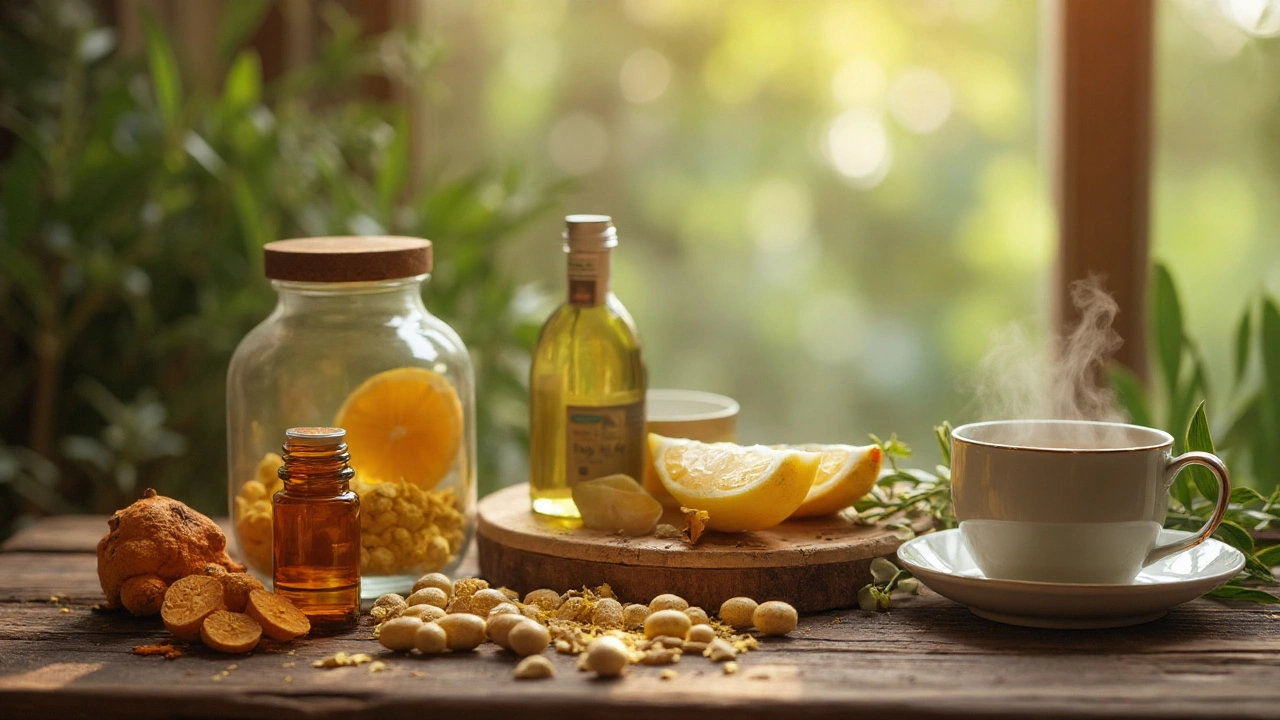Liver Inflammation Risk Checker
Enter Your Information
Liver inflammation is a condition where the liver’s tissue becomes swollen and damaged, often marked by elevated liver enzymes and a heightened immune response. It’s a silent driver behind fatigue, metabolic hiccups, and eventually fibrosis. If you’ve been told your ALT or AST numbers are up, or you’ve heard the term “fatty liver” tossed around, you’re staring at the same problem from different angles.
Why Inflammation Happens: The Core Triggers
Three main forces light the fire:
- Excess calories, especially from refined carbs and sugary drinks, push hepatocytes to store fat.
- Persistent exposure to toxins - alcohol, certain medications, industrial chemicals - up‑regulates pro‑inflammatory cytokines.
- An out‑of‑balance gut microbiome leaks lipopolysaccharide (LPS) into the portal vein, spurring the liver’s immune cells.
Understanding the cause lets you target the fix.
Key Player #1: Hepatocytes are the liver’s primary functional cells, responsible for detoxifying, producing bile, and regulating metabolism. When they get overloaded with fat, they release reactive oxygen species (ROS) that attract immune cells, creating a vicious cycle of oxidative stress.
Key Player #2: Non‑Alcoholic Fatty Liver Disease (NAFLD) is the umbrella term for fat accumulation without significant alcohol intake. Roughly 25% of U.S. adults live with NAFLD, and about a third of those progress to non‑alcoholic steatohepatitis (NASH), a more inflamed state.
Dietary Arsenal: Food That Quiets the Liver
Dietary Arsenal: Food That Quiets the Liver
Fresh, whole foods beat processed snacks every time. Below is a quick‑read table comparing four of the most studied anti‑inflammatory foods.
| Food | Primary Active Compound | Typical Daily Dose | Research Evidence (Scale 1‑5) |
|---|---|---|---|
| Turmeric (Curcumin) | Curcumin | 500‑1000mg (standardized) | 4 |
| Fatty Fish (Omega‑3) | Eicosapentaenoic Acid (EPA) & Docosahexaenoic Acid (DHA) | 2‑3servings per week (≈250‑500mg EPA/DHA) | 5 |
| Coffee (Brewed) | Cafestol & Chlorogenic Acid | 2‑3 cups (≈200‑300mg chlorogenic acid) | 3 |
| Green Tea | Epigallocatechin‑Gallate (EGCG) | 2‑3 cups (≈300‑400mg EGCG) | 4 |
These foods share two traits: they boost antioxidant pathways (like Nrf2) and lower NF‑κB signaling, the molecular switch for inflammation.
Meal Blueprint: The Mediterranean Liver‑Friendly Plate
The Mediterranean diet is a plant‑forward eating pattern rich in olive oil, nuts, legumes, whole grains, fish, and modest wine. Studies from the European Association for the Study of the Liver (EASL) show that participants who followed this diet for 12 months reduced ALT by 30% on average.
Build each meal around three zones:
- Healthy fats: 1‑2 tbsp extra‑virgin olive oil or a handful of walnuts.
- Fiber & phytonutrients: half the plate of colorful veggies (broccoli, peppers, leafy greens).
- Protein: grilled salmon, sardines, or legumes; limit red meat to once a week.
Swap sugary desserts for fresh berries with a drizzle of honey - the natural fructose load stays low enough to keep hepatocyte fat synthesis in check.
Supplements That Back Up Food
When diet alone isn’t enough, targeted supplements can tip the balance.
- Curcumin (from turmeric) has been shown in randomized trials to cut liver enzymes by up to 25% when paired with piperine for absorption.
- Omega‑3 fatty acids (EPA/DHA) lower triglycerides, a key driver of hepatic fat, and improve insulin sensitivity.
- VitaminE (400IU per day) is an antioxidant approved by the American Association for the Study of Liver Diseases for non‑diabetic NASH patients.
- Silymarin (milk thistle extract) stabilizes hepatocyte membranes and may reduce fibrosis progression.
Remember: supplements support, they don’t replace, a balanced diet.

Lifestyle Levers: Move, Sleep, and Gut Balance
Physical activity is a silent liver hero. Moderate‑intensity aerobic exercise (30minutes, 5×/week) burns visceral fat, which directly reduces hepatic fat stores. Resistance training adds a bonus by increasing lean muscle mass, improving glucose uptake.
Sleep deprivation spikes cortisol, which drives gluconeogenesis and pushes the liver toward inflammation. Aim for 7‑9 hours of consistent, quality sleep.
The Gut microbiome is a bustling community of bacteria that ferment fiber into short‑chain fatty acids (SCFAs) like butyrate, which dampen liver inflammation via the gut‑liver axis. Include prebiotic foods (onion, garlic, asparagus) and probiotic sources (yogurt, kefir, fermented vegetables) to keep the barrier tight and LPS leakage low.
Tracking Progress: Labs and Imaging
Seeing is believing. The simplest way to monitor improvement is through blood work:
- ALT (alanine aminotransferase) - a drop of 5‑10U/L after 8‑12 weeks signals reduced hepatocyte injury.
- AST (aspartate aminotransferase) - follow the same trend as ALT.
- FIB‑4 score - a calculated index using age, AST, ALT, and platelet count that estimates fibrosis risk.
Imaging options like FibroScan or an abdominal ultrasound give a visual snapshot of fat percentage and stiffness. If scores stay stable or improve, you’re on the right track.
When to Call a Professional
If you notice any of these red flags, seek medical advice promptly:
- Persistent jaundice or dark urine.
- Significant weight loss without trying.
- Abdominal pain that worsens after meals.
- Elevated liver enzymes that don’t improve after 3 months of lifestyle changes.
Specialists may order a liver biopsy to differentiate simple steatosis from NASH, guiding more aggressive interventions.
Putting It All Together: A 7‑Day Action Plan
Below is a practical, day‑by‑day starter you can adapt.
- Morning: 1 cup brewed coffee, 2 boiled eggs with spinach, 1 slice whole‑grain toast.
- Mid‑morning snack: ¼ cup mixed berries + 1tbsp ground flaxseed.
- Lunch: Mediterranean bowl - quinoa, grilled salmon, roasted veg, drizzle olive oil, sprinkle walnuts.
- Afternoon: 1 cup green tea, 1small apple.
- Dinner: Stir‑fried tofu with broccoli, bell pepper, ginger; serve over cauliflower rice.
- Evening: ½ cup kefir, 500mg curcumin capsule with black‑pepper extract.
- Movement: 30‑minute brisk walk after dinner; two 10‑minute strength sessions on alternate days.
Stick with this for a week, then tweak portions and foods based on your preferences and lab feedback.
Bottom Line
The easiest path to reduce liver inflammation blends three pillars: a Mediterranean‑style diet rich in proven anti‑inflammatory foods, targeted supplements, and consistent movement plus sleep. Pair those with regular lab checks and you’ll keep your liver humming for years to come.

Frequently Asked Questions
Can coffee really help a inflamed liver?
Yes. Moderate coffee consumption (2‑3 cups daily) has been linked to lower ALT levels and a reduced risk of fibrosis. The protective compounds are cafestol and chlorogenic acid, which enhance antioxidant pathways.
Is fatty liver reversible?
In most people, early‑stage fatty liver is fully reversible with weight loss, diet changes, and exercise. Studies show a 5‑10% body‑weight reduction can cut liver fat by half.
What dose of curcumin should I take?
Clinical trials use 500‑1000mg of standardized curcumin daily, ideally paired with 5mg piperine to boost absorption. Start at the low end and monitor liver enzymes after 8 weeks.
Do I need a supplement if I already eat fish twice a week?
If you meet the recommended EPA/DHA intake (250‑500mg per day) through fatty fish, additional omega‑3 isn’t mandatory. However, if you’re vegetarian or have limited fish intake, a high‑quality algae‑based supplement can fill the gap.
How often should I get liver labs checked?
For someone making lifestyle changes, every 3‑6 months is reasonable. If you have diabetes, obesity, or a family history of liver disease, discuss a more frequent schedule with your provider.

